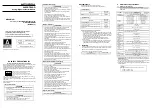
67
Ingeteam Energy, S.A.
AAV2000IKI01
Installation manual
8.1.2. Orange LED
This LED indicates that alarms have been set off in the inverter.
Fast flashing
This flashing indicates that an alarm has occurred in the inverter, but the anomaly in the operation does not require
stopping the inverter. The most frequent alarm of this type is the high temperature protection:
The inverter is in self-limiting mode because it has reached the maximum permissible temperature.
In this situation, check that the fans are running, that the air inlets and vents are free from obstacles, and that there
are no sources of intense heat near the inverter. If the problem persists, contact Ingeteam Energy S.A.
8.1.3. Red LED
This LED indicates that alarms have been set off in the inverter.
Steady light
The inverter shuts down. This flashing indicates that an alarm has occurred in the inverter which requires it to shut
down. The most common alarms that require inverter shutdown are:
1000H
Manual shutdown. The unit has been stopped manually. Check that the emergency stop buttons have
not being pressed accidentally, and try to restart from the display by removing the manual shutdown.
0001H
Grid frequency out of range.
0002H
Grid voltage out of range.
Chances are that the problem is a power failure. When power returns, the inverter will restart. If not,
check the connections to the grid.
If the grid has the appropriate grid quality parameters, check the grid connections.
If the problem persists, contact Ingeteam Energy S.A.
0400H
Insulation fault in DC circuit.
There are two possible causes:
•
There is an insulation fault on the panel circuit.
•
An arrester has triggered.
0020H
Temperature alarm in the power electronics.
The temperature of the unit is too high and has stopped feeding current to the grid. When the tempera-
ture drops, the unit will reconnect.
An insulation fault can pose a hazard to personnel.
The repair of an insulation fault must be carried out by qualified personnel.
Procedure to determine the cause of the insulation fault
1.
Open the DC circuit breaker. If the voltages of the PV array with respect to ground are in balance, the insula-
tion fault is outside the inverter.
2.
If the insulation fault persists, the fault is inside the unit. Check the surge arresters.
3.
Disconnect the unit from the power grid and the PV array.
4.
Wait at least 10 minutes for the capacitances to discharge.
5.
Open the inverter and check the status of the DC arresters. Each of these arresters has an visual indicator.
If the indicator is black, the arrester has been triggered.
6.
Check the status of the DC fuses or thermomagnetic circuit breaker protecting the arresters.
7.
Replace defective components if necessary.
Содержание Ingecon Sun 250 TL
Страница 1: ...Ingecon Sun Power Max Installation manual...
Страница 91: ...Notes...
















































